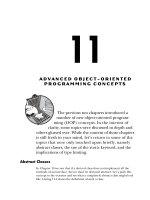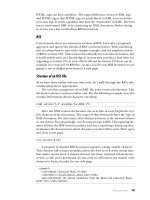OBJECT-ORIENTED PHP Concepts, Techniques, and Code- P17 pps
Bạn đang xem bản rút gọn của tài liệu. Xem và tải ngay bản đầy đủ của tài liệu tại đây (266.91 KB, 10 trang )
Extending SQLite 141
How It’s Done
In this application we take advantage of some of SQLite’s advanced capa-
bilities. Both triggers and views will be used. A trigger, code that executes in
response to an add, edit, or delete event, will be used to mimic a datestamp
field—records will be automatically stamped whenever they are added or
changed.
Views are a convenient way of storing queries and can replace tables in
the
FROM clause of a SELECT statement. They can also be used with triggers so
that “updating” a view updates the associated table.
No database used in conjunction with PHP can escape comparison to
MySQL. Where appropriate, I will point out differences in SQL syntax
between SQLite and MySQL. Likewise, SQLite has a variety of different query
methods. These will also be contrasted with MySQL functions.
As you have seen, throwing exceptions rather than trapping errors
makes for cleaner code. SQLite has a built-in OO interface, and there is an
SQLiteException class. However, only the SQLite database constructor throws
exceptions. By extending the SQLite database class, we can override the query
methods so that a failed query also throws an exception. This derived class will
also include data verification methods that make use of metadata extracted
from the database. This will be done by querying the
sqlite_master table and
through the use of pragmas. A pragma modifies the way the SQLite library
works but can also be used to query the database structure. We’re only inter-
ested in the second use.
A limited number of functions are available for use with SQLite’s dialect
of SQL. You’ll see how this shortcoming can be overcome by creating user-
defined functions (UDFs).
Getting Started
SQLite comes bundled with PHP 5, so all you have to do to install the database
is run the
db_install_script.php file.
However, if you do things this way you’ll have to write code just to view
your data or to examine the structure of your database. You might want to
download the command-line version of SQLite instead. PHP 5, depending
upon the subversion number, comes with SQLite versions 2.8.11 through
2.8.17. To find out which version is running on your system, display the
results of the PHP function
phpinfo in your browser and search for SQLite.
For convenience, you might want to install the binary of
sqlite in the same
directory as your database.
Creating a database is as simple as typing the name of the SQLite
executable file at the command line followed by the database name—for
example,
sqlite resources.sqlite. Doing so will run sqlite and create or
open an existing database of the specified name. You can now create a
table using SQL from the command line. However, let me make one more
suggestion. At some point you will want to dump your database, and if you
have created it from the command line the output won’t be very readable.
OOPHP_02.book Page 141 Friday, May 5, 2006 2:25 PM
142 Chapter 15
If you use a text editor to format your CREATE TABLE statement and then
redirect this file to the database, the results will be much more acceptable.
Do this whenever you create tables, views, or triggers.
NOTE Precompiled binaries for most operating systems are available at the SQLite download
page ( For compatibility reasons it is important to get
the command-line version number that matches the version incorporated into PHP. At the
SQLite site you may have difficulty finding older versions. If there is no link to the
version you require, enter the URL , followed by the version number
you require, into the address bar of your browser—for example, />sqlite-2_8_16.zip. You might get away with using a slightly higher or lower version
number, but version 3 databases are an entirely different format from version 2, so do
not attempt to use the version 3 command-line tool with a version 2 database.
The database used in this application is called
resources.sqlite and is
stored in a subdirectory named
dbdir. If you haven’t already created it using
the
db_install_script.php file, you can do so by redirecting the dump.sql file
from the command line in the following way:
sqlite resources.sqlite < dump.sql
A database dump is formatted as a transaction, so, if this command
worked properly, you’ve already used one of SQLite’s advanced features.
You can test that the database has been installed by executing a
SELECT
statement. Typing
SELECT * FROM tblresources; should display all the records
in the resources table.
Creating a Table
The SQL used to create the tblresources table in our database is shown in
Listing 15-1.
CREATE TABLE tblresources(
id INTEGER PRIMARY KEY,
url VARCHAR(255) NOT NULL UNIQUE default '',
email VARCHAR(70) NOT NULL default '',
precedingcopy VARCHAR(100) NOT NULL default '',
linktext VARCHAR(255) NOT NULL default '',
followingcopy VARCHAR(255) NOT NULL default '',
target VARCHAR(35) default '_blank',
category VARCHAR(100) NOT NULL default '',
theirlinkpage VARCHAR(100) default NULL,
whenaltered TIMESTAMP default '0000-00-00',
reviewed BOOLEAN default 0,
whenadded DATE default '2006-05-05');
Listing 15-1: Creating a table
OOPHP_02.book Page 142 Friday, May 5, 2006 2:25 PM
Extending SQLite 143
Let’s have a look at the details.
To create a table with an autonumber field named
id, the data type INTEGER
is used in conjunction with
PRIMARY KEY. This is equivalent to identifying a field
as
INTEGER auto_increment PRIMARY KEY in MySQL. In SQLite this field definition
is the one exception to the rule that SQLite fields are typeless—otherwise all
fields are strings. Creating fields as types other than string helps document
the data types you are expecting but will not restrict the value entered. You can
put a string into a float type field and a float into a Boolean. Further, specify-
ing the length of a
VARCHAR type field will not truncate data that exceeds the
defined length. Any length of string can be entered into any field. Otherwise,
the syntax for creating a table functions exactly as you might expect.
The field names used in creating this table are self-documenting, but a
few comments are in order. A resource won’t be displayed until the
reviewed
field is set to
true. The field with the data type TIMESTAMP whenaltered will be
maintained using a trigger as will the
whenadded field.
Views
Views are stored SELECT queries. If you repeatedly use the same query, it is
worthwhile creating it as a view.
To make resource links easily accessible, let’s order them alphabetically
and create hyperlinks to each letter of the alphabet. With this in mind, take a
look at the
alphabet view shown in Listing 15-2.
CREATE VIEW alphabet AS
SELECT DISTINCT UPPER(SUBSTR(linktext,1,1)) AS letter
FROM tblresources
WHERE reviewed = 1
ORDER BY letter;
CREATE VIEW specific_link AS
SELECT id, url,
(precedingcopy || ' ' || linktext || ' ' || followingcopy)
AS copy
FROM tblresources;
Listing 15-2: Views
The alphabet view creates a row of links as pictured at the top of
Figure 15-1.
Rather than repeat the SQL statement that makes up the
alphabet view,
we can instead simply
SELECT * FROM alphabet using the name of the view in the
FROM clause.
The second view,
specific_link, also shown in Listing 15-2, demonstrates
how a view can be “updated” when used in conjunction with a trigger. We will
return to this view in the following discussion about triggers, but do note the
use of
|| as the string concatenation operator.
As you can see, SQLite defines its own string manipulation functions. For a
complete list of functions and operators, see www.sqlite.org/lang_expr.html.
OOPHP_02.book Page 143 Friday, May 5, 2006 2:25 PM
144 Chapter 15
Triggers
For those programmers who pride themselves on their laziness, triggers are a
wonderful thing. By creating a trigger you can get maximum effect with mini-
mum effort.
Triggers are activated by an
INSERT, DELETE, or UPDATE SQL statement. They
are often used to maintain referential integrity and avoid orphaned records—
for example, deleting an invoice might well trigger deletion of all related
invoice items. We’re going to create three triggers for our application: one
to mimic a timestamp field, another to show the advantages of laziness, and
finally a trigger to demonstrate how a view can be “updated.”
The timestamp triggers are shown in Listing 15-3. They are activated
whenever a record in the
tblresources table is added or updated.
CREATE TRIGGER insert_resources AFTER INSERT ON tblresources
BEGIN
UPDATE tblresources SET whenaltered = DATETIME('NOW','LOCALTIME')
WHERE id = new.id;
END;
CREATE TRIGGER update_resources AFTER UPDATE ON tblresources
BEGIN
UPDATE tblresources SET whenaltered = DATETIME('NOW','LOCALTIME')
WHERE id = new.id;
END;
CREATE TRIGGER add_date AFTER INSERT ON tblresources
BEGIN
UPDATE tblresources SET whenadded = DATE('NOW','LOCALTIME')
WHERE id = new.id;
END;
CREATE TRIGGER delete_link INSTEAD OF DELETE ON specific_link
FOR EACH ROW
BEGIN
DELETE FROM tblresources
WHERE id = old.id;
END;
Listing 15-3: Triggers
There is no need to remember to update the whenaltered field each time
a change is made to a record—the
insert_resources and update_resources
triggers will do this for you. The current date and time will be added in the
background. Effectively, this field will now function like a MYSQL
TIMESTAMP
field.
Likewise with the
add_date trigger, also shown in Listing 15-3. We want to
highlight new links. This trigger makes it possible to capture the date a link
is added. By using a trigger we don’t have to worry about forgetting to main-
tain this field, and we don’t have to write additional code each time a record
is added.
OOPHP_02.book Page 144 Friday, May 5, 2006 2:25 PM
Extending SQLite 145
Creating a trigger on a view is a convenient way of performing an “update”
against a view. By themselves, views are not updatable. If you attempt to delete
from a view that has no associated trigger, you’ll get a warning like the
following:
Warning: SQLiteDatabase::query() [function.query]: cannot
modify specific_link because it is a view
We solved this problem in the trigger we created on the view specific_link
shown in Listing 15-3. Because we used an
INSTEAD OF clause, any attempt to
delete from this view instead removes the appropriate record from the
table,
tblresources.
In this trigger we have specified
FOR EACH ROW. Doing so is optional.
A
FOR EACH STATEMENT clause also exists but is not yet supported.
The
WHERE clause of a trigger is somewhat intuitive but may cause some
confusion. Using
new.id to specify a newly inserted record and old.id for a
deleted record clearly makes sense. Either
old or new may be used when a
record is updated.
Using triggers is very convenient, although the same effect could be
achieved programmatically. But because triggers are embedded in the data-
base, they are activated even when you make changes from the command
line. Triggers help maintain the integrity of your database when it is modified
outside of your application. Laziness has its rewards.
PHP Implementation of SQLite
For the most part, the OO methods of SQLite are exactly the same as the
procedural functions. The only difference is that the leading
sqlite is
dropped and the studly caps naming convention is used in place of under-
scores (although some methods added in version 5.1 don’t quite follow this
rule). Method parameters are the same as those used with the procedural
functions, except that there is no need to pass a resource handle since the
object itself is the handle. A few functions are only available in a procedural
form; these will be mentioned where appropriate.
There are three built-in, ready-to-use SQLite objects: an SQLite database,
a buffered result set, and an unbuffered result set. All three classes will be used
in this chapter, but the focus will be on the database class.
Extending SQLiteDatabase
One of the nice things about object-oriented programming (OOP) is excep-
tion handling. Procedural error trapping is not only tedious, it clutters up
your code and can make it unreadable. Taking an OO approach and using
exception handling sounds like the ideal solution—until you realize that the
database constructor is the only method of all the SQLite classes that throws
OOPHP_02.book Page 145 Friday, May 5, 2006 2:25 PM
146 Chapter 15
an exception. If you want to check for errors when creating result sets, you
are stuck using procedural code. It looks like we’re right back where we
started.
We’ll next discuss how this can be fixed.
Override the Query Methods
The simple solution to this problem is inheritance. On the surface, this
would seem fairly straightforward: Create a class that extends
SQLiteDatabase
and override all the query methods. If errors arise within those overridden
methods, simply throw an exception. In this way, the messy details of error
trapping can be buried inside the class file and a single
catch block can handle
all errors. The first five methods in the class definition file shown in Listing 15-4
do exactly this.
//////////////////////////////////////////////////////////////
//public functions related to queries
/**
Override function
*/
public function query($strsql, $type = SQLITE_BOTH, &$err_msg = ''){
//SQLiteResult query ( string query [, int result_type [, string &error_msg]] )
if ( false === $result = parent::query($strsql, $type, $err_msg)){
//no sql details with last error
throw new SQLiteException (sqlite_error_string($this->lastError()));
}
return $result;
}
//////////////////////////////////////////////////////////////
/**
Override function
*/
public function unbufferedQuery($strsql, $type = SQLITE_BOTH, &$err_msg = ''){
//SQLiteUnbuffered unbufferedQuery ( string query [, int result_type [, string
&error_msg]] )
if ( false === $result = parent::unbufferedQuery($strsql, $type, $err_msg)){
throw new SQLiteException (sqlite_error_string($this->lastError()));
}
return $result;
}
//////////////////////////////////////////////////////////////
/**
Override function
*/
public function singleQuery($strsql, $first_column = true, $bin_decode = false){
//array sqlite_single_query ( resource db, string query [, bool first_row_only [, bool
decode_binary]] )
if ( false === $result = parent::singleQuery($strsql, $first_column, $bin_decode)){
throw new SQLiteException (sqlite_error_string($this->lastError()));
}
return $result;
}
OOPHP_02.book Page 146 Friday, May 5, 2006 2:25 PM
Extending SQLite 147
//////////////////////////////////////////////////////////////
/**
Override function
*/
public function queryExec($strsql, &$err_msg = ''){
//bool queryExec ( string query [, string &error_msg] )
if ( !parent::queryExec($strsql, $err_msg)){
throw new SQLiteException (sqlite_error_string($this->lastError()));
}
return true;
}
//////////////////////////////////////////////////////////////
/**
Override function
*/
public function arrayQuery($strsql, $type = SQLITE_BOTH, $bin_decode = false ){
//array arrayQuery ( string query [, int result_type [, bool decode_binary]] )
if ( false === $result = parent::arrayQuery($strsql, $type, $bin_decode)){
throw new SQLiteException (sqlite_error_string($this->lastError()));
}
return $result;
}
//////////////////////////////////////////////////////////////
Listing 15-4: Extending the
SQLiteDatabase class
In each case, the query method of the parent class, SQLiteDatabase, is
redefined to include a test of the return value.
Error Messages
The comment immediately inside each method definition shows the method
prototype as defined on the PHP site. This is especially useful because it shows
the type of object returned. Some of the base class methods take an optional
string reference argument (
&$error_msg).
NOTE In versions of PHP prior to 5.1, passing in this string reference results in this warning:
SQLiteDatabase::query() expects at most 2 parameters, 3 given.
The reason a third parameter is necessary is explained as follows (from
/> [$error_msg] will be filled if an error occurs.
This is especially important because SQL syntax errors can’t be
fetched using the [
sqlite_last_error()] function.
Quite true. The sqlite_last_error function returns an uninformative
message:
SQL logic error or missing database. Our code doesn’t make use
of this error message but this isn’t an insurmountable problem. A more
specific error message would certainly help in the debugging process, how-
ever. Fortunately, if you have warnings turned on while you are developing,
OOPHP_02.book Page 147 Friday, May 5, 2006 2:25 PM
148 Chapter 15
you will get something more meaningful. Forcing a warning by referencing a
nonexistent table results in the following, more specific, output:
Warning: SQLiteDatabase::query()[function.query]: no such
table: tblnonexistent
Query Methods
Look again at Listing 15-4. It includes the five methods for creating result
sets. The buffered and unbuffered methods are fairly self-explanatory—you
are probably quite familiar with the equivalent MySQL functions. However,
MySQL (prior to the MySQL improved extension) has nothing to match the
singleQuery, queryExec, or arrayQuery methods. Let’s look at these methods in
more detail.
The
singleQuery method is a recent addition, and the PHP site warns that
it is not currently documented. Let’s carry on regardless because this method
looks especially useful for those situations where a query returns only one
row—when using the
COUNT function to return the number of records in a
table, for example. Here’s one view of how this method ought to behave: This
method returns only one record, and no result set is created. If the second
argument is false, the value returned is an array of the first row. If the sec-
ond argument is true, then only the first column of the first row is returned,
and it is returned as a scalar value.
This speculation may make the best sense of how this method ought to
work, but it doesn’t describe what actually happens. In fact, this method only
ever returns the first column and any number of rows. If the second argument
is false, then an array is returned; if the second argument is true and only one
row is returned, a scalar is returned. On the PHP site, this second argument
is identified as
bool first_row_only and the return type is identified as an array.
It looks like the return type should be
mixed. In any case, this method doesn’t
yet work the way it ought to. We were warned.
There is no requirement that you use the
singleQuery method instead
of
query. As with MySQL, you can always create a result set and then use the
appropriate
fetch function to retrieve the value of the first row or a specific
field. But why return an object or an array when all that’s needed is the value
of one column? You may use the
singleQuery method for any kind of query—
data manipulation or otherwise—but it was designed specifically for situa-
tions where a single value or single column is returned, and is presumably
optimized for this situation.
As you can see, there is also an
arrayQuery method. Like the singleQuery
method, this method allows us to directly copy results into an array, bypassing
the intermediate step of creating a result set. This method is best used when
a limited number of records are returned.
MySQL versions prior to 4.1 have no equivalent to the
queryExec method of
SQLite because
queryExec is specifically designed for use with multiple queries.
Multiple, semicolon-separated queries may be passed as a single query string to
queryExec. (The install script uses this method to create the tables, triggers, and
views and to insert records into the
tblresources table.) This method gives
significant performance improvements over repeated querying and performs
OOPHP_02.book Page 148 Friday, May 5, 2006 2:25 PM
Extending SQLite 149
the same job as the MySQL-improved (the mysqli functions added to PHP 5 to
support MySQL 4.1) method,
mysqli_multi_query. If you like, you can of course
use this method to execute a single query.
query
Use of this method to create an SQLiteResult object is shown in Listing 15-5.
$db = new SQLiteDatabasePlus('resources.sqlite');
//alphabet view
$strsql = "SELECT * FROM alphabet";
//use buffered result set to get number of rows
$result = $db->query($strsql);
//create alphabet here
if($result->numRows() > 0){
echo get_alphabet($result);
}
Listing 15-5: query method returns a buffered result set
Remember, an SQLiteResult is buffered so you can use the numRows method
with this result set. It is also iterable, so this result set may be used in a
foreach
loop. In this, SQLite differs from MySQL. Because
SQLiteResult implements
Iterator, all the iterator methods are present—rewind, next, valid, and current.
These methods can be used directly, but their real purpose is to allow an
SQLite result set to be used in a
foreach loop in exactly the same way that you
might use an array. (As you might expect, the
rewind method can’t be applied
to an unbuffered result set.) Only this method and the unbuffered query
method return a result set object.
unbufferedQuery
There is no need to buffer the result set returned in Listing 15-6.
try{
$db = new SQLiteDatabasePlus(' /dbdir/resources.sqlite');
$type="Edit";
//retrieve from db
$strsql = "SELECT * FROM tblresources ".
"WHERE id = '$id'";
//get recordset as row
$result = $db->unbufferedQuery($strsql);
$row = $result->fetch();
//can't use below because returns first column only
//$row = $db->singleQuery($strsql, false);
// assume vars same as fields
while(list($var, $val)=each($row)) {
$$var=$val;
}
}catch(SQLiteException $e){
//debug msg
echo $e->getMessage();
}
}
Listing 15-6: The
unbufferedQuery method
OOPHP_02.book Page 149 Friday, May 5, 2006 2:25 PM
150 Chapter 15
This listing shows an unbuffered query. In this case, a functional
singleQuery method would be preferable because we know that only one
record will be returned. However, given the problems with
singleQuery, we
use the
unbufferedQuery method of an SQLiteDatabase object to create a result
set object and then use the
fetch method to copy the first row into an array.
arrayQuery
The PHP site warns against using the arrayQuery method with queries that
return more than 45 records (a somewhat arbitrary number perhaps, but
this method stores results in memory so returning a large number of records
can exhaust memory). We’ve used this method in Listing 15-7.
$db = new SQLiteDatabasePlus(' /dbdir/resources.sqlite');
$db->createFunction('class_id','set_class_id',0);
$sql = "SELECT id, url, email, ".
"(precedingcopy || ' ' || linktext || ' ' || followingcopy) ".
"AS copy, linktext, reviewed, class_id() AS classid ".
"FROM tblresources ".
"ORDER BY id DESC ".
"LIMIT $recordoffset,". PERPAGE;
//use arrayQuery
$resultarray = $db->arrayQuery($sql);
Listing 15-7: Using
arrayQuery
As you can see, we know exactly how many records are returned because
our SQL has a
LIMIT clause. Again, this method allows us to bypass creation of
a result set.
singleQuery
The code below uses the singleQuery method and does exactly what we
need—it returns a single scalar value rather than a result set or an array.
$totalrecords = $db->singleQuery('Select COUNT(*) FROM
tblresources', true);
queryExec
This method is commonly used to process a transaction. Use the command-
line command
.dump to dump your database or view the file dump.sql. You’ll
see that it is formatted as a transaction. You can recreate an entire database
by passing this listing as a string to the
queryExec method, as we have done
with the install script,
db_install_script.php.
The ability to perform multiple queries using one string does raise
security issues. When using this query method, it is especially important to
filter data in order to avoid a possible SQL injection attack. For more details,
see php|architect’s Guide to PHP Security.
1
1
Ilia Alshanetsky, php|architect’s Guide to PHP Security (Marco Tabini & Associates, Inc., 2005), 73.
OOPHP_02.book Page 150 Friday, May 5, 2006 2:25 PM









